Mole Removal with CO2 Laser – Qualified, painless, affordable treatment – Laval and the greater Montreal area
Before removing a mole
Moles are skin formations, generally dark, derived from the cells that pigment the skin (melanocytes). At LABELLE Clinic we offer advanced treatments with CO2 Laser in order to manage and treat this condition. Most people have moles, but the propensity to develop atypical moles is sometimes hereditary. Moles and atypical moles that change significantly should be biopsied to screen for melanoma, a skin cancer. Melanoma is a rare but very dangerous skin cancer, as it causes metastases in approximately 20% of cases. It can develop on any part of the body although it most often appears on areas that have been exposed to the sun. This type of cancer can appear on an area of “normal” skin or develop from a mole. Preventing skin cancer involves regularly monitoring your skin and moles to detect possible cancer cells at an early stage. We can use the “ABCDE rule” to recognize an atypical mole: Asymmetry, Irregular edges, Non-uniform color, Diameter greater than 6 mm, Rapid development. A nevus or “mole” is a grouping of pigment cells in the skin. It is most often characterized by a small brown or pink spot, which appears in the first decades of life. There are different types of nevus depending on their shape, color, location and development. The melanocytic nevus, more commonly called a beauty spot or mole, is a small spot, usually circular or oval, located on the top of the skin. It can be flat or raised, smooth or rough, and sometimes covered in hair. It can be flesh-colored, yellow, brown, blue-gray or almost black.
Variety of moles
There are different types of moles depending on their shape, color, location and development. Moles are skin formations, generally dark, derived from the cells that pigment the skin (melanocytes). Here are some varieties of moles:
- Congenital moles
Congenital moles are those that are present at birth. They can be of different sizes and colors. These types of moles are classified as small (less than 1.5 centimeters), medium (1.5 to 20 centimeters), large (20 to 40 centimeters), and giant (more than 40 centimeters). Large and giant congenital nevi are rare, and in all cases they grow proportionally during development.
- Acquired moles
Acquired moles are the most common types of moles we can find. They usually appear during childhood or adolescence, and can be influenced by genetic or environmental factors, such as exposure to the sun. They have a circular or oval appearance, with well-defined edges, and a flesh color, yellow, brown, blue-gray or almost black. They can be flat or raised, smooth or rough, and sometimes covered in hair.
- Spitz moles
Spitz moles are moles that are often confused with melanomas because they have an irregular appearance and a red, pink, or dark brown color. They are more common in children and adolescents, and are often located on the face, neck or limbs. They are generally benign, but it is recommended to monitor them regularly and consult a dermatologist if in doubt.
- Atypical moles
Atypical moles are moles that have abnormal characteristics, such as asymmetry, irregular edges, non-uniform color, diameter greater than 6 mm, or rapid growth. These moles are considered risk factors for melanoma, a rare but very dangerous skin cancer. It is therefore important to examine them frequently and have them evaluated by a specialist.
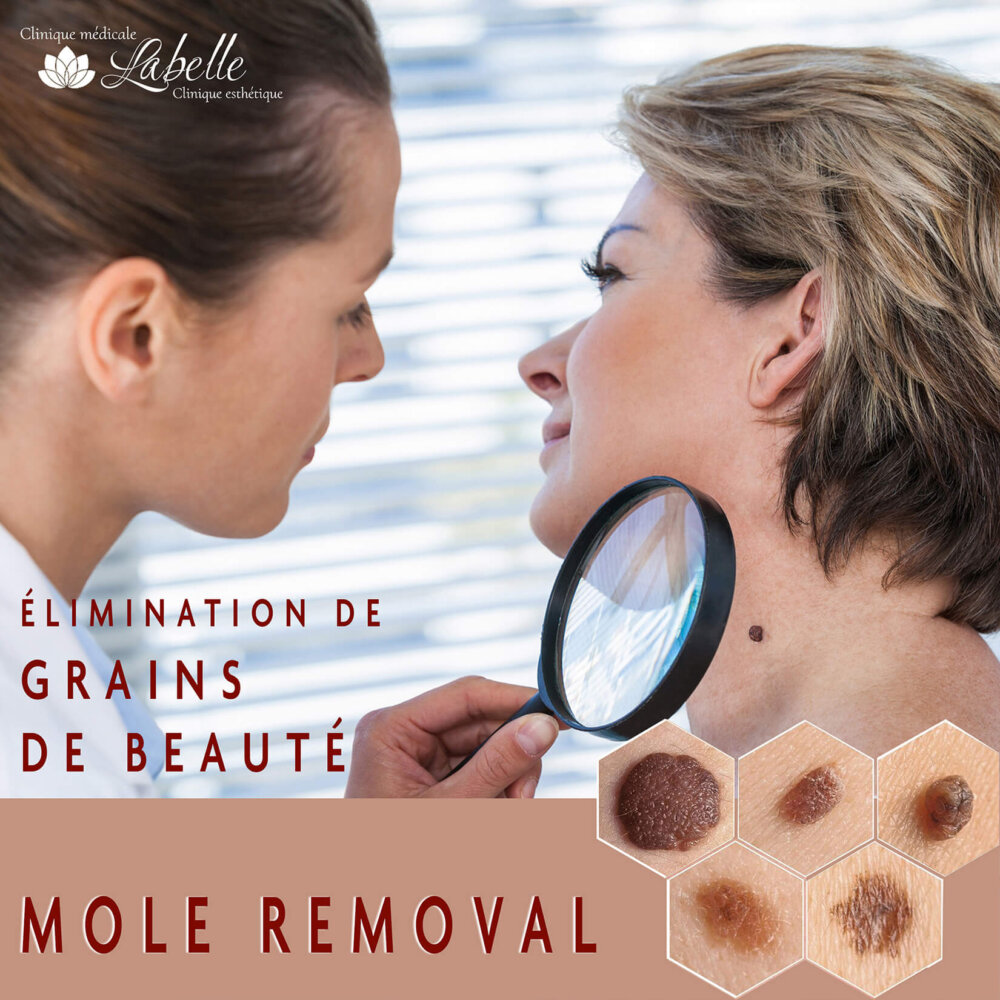
Areas where moles frequently appear
Moles usually appear on:
- the face
- the arm
- the back
- the legs
These are the main areas exposed to the sun. Indeed, moles are caused by a high concentration of melanin, a pigment present in the skin.
Exposure to the sun (particularly during childhood): the most common external cause generally leading to the development of moles on the face, neck, arms, hands — the most exposed areas. A familial predisposition for the development of moles.
The moles present on our body can sometimes change their appearance. We then speak of atypical moles, also called dysplastic nevi. This change is not necessarily serious, but it should prompt you to consult a doctor, because the presence of an atypical mole on the skin increases the risk of melanoma, the most aggressive skin cancer. We explain how to recognize an atypical mole.
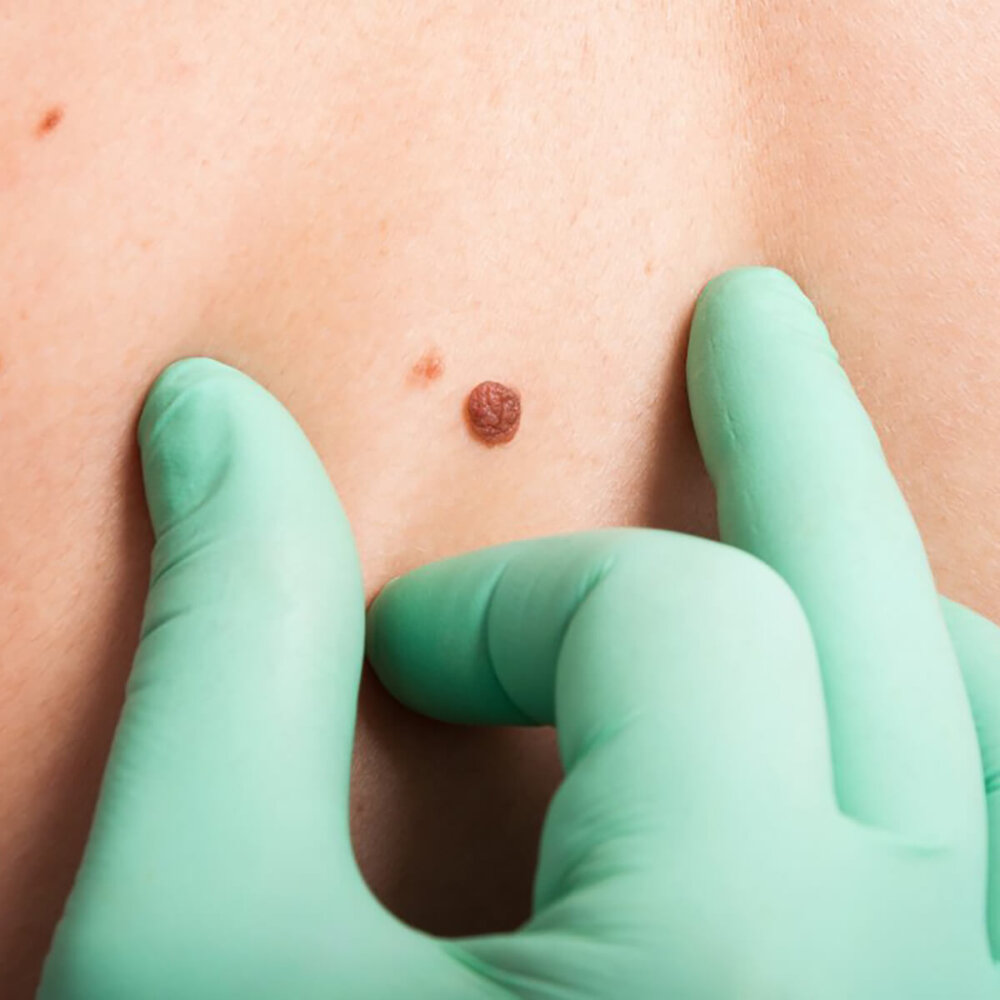
Remove moles with CO2 Laser?
Treatment of moles with the CO2 laser is a technique that allows skin growths to be removed quickly and painlessly. The CO2 laser is an ablative laser, meaning it destroys the pigment cells responsible for the color of the mole.
The fractional CO2 laser is particularly suitable for treating raised moles, such as dermal nevi or Spitz moles. The CO2 laser can also be used to reduce scars left by acne or chickenpox.
Advantages of CO2 Laser in the Treatment of Mole Removal
The treatment is carried out under local anesthesia, on an outpatient basis, that is to say without hospitalization. The laser beam is directed at the mole to be removed, and vaporizes it in a few seconds. A small crust forms on the treated area, and falls off after a few days. You must then protect the skin from the sun for a few months, as it can remain red and sensitive.
The main advantage of the CO2 laser is that it does not leave a scar, unlike traditional surgery.
Treating moles with the CO2 laser is an effective and safe method, provided it is carried out by an experienced and qualified doctor. You must also ensure that the mole to be treated does not present a risk of skin cancer, such as melanoma.
For this, it is recommended to consult a doctor before treatment, and to regularly monitor the evolution of your moles. If you notice a change in shape, color, size or sensation in a mole, do not hesitate to consult a specialist.
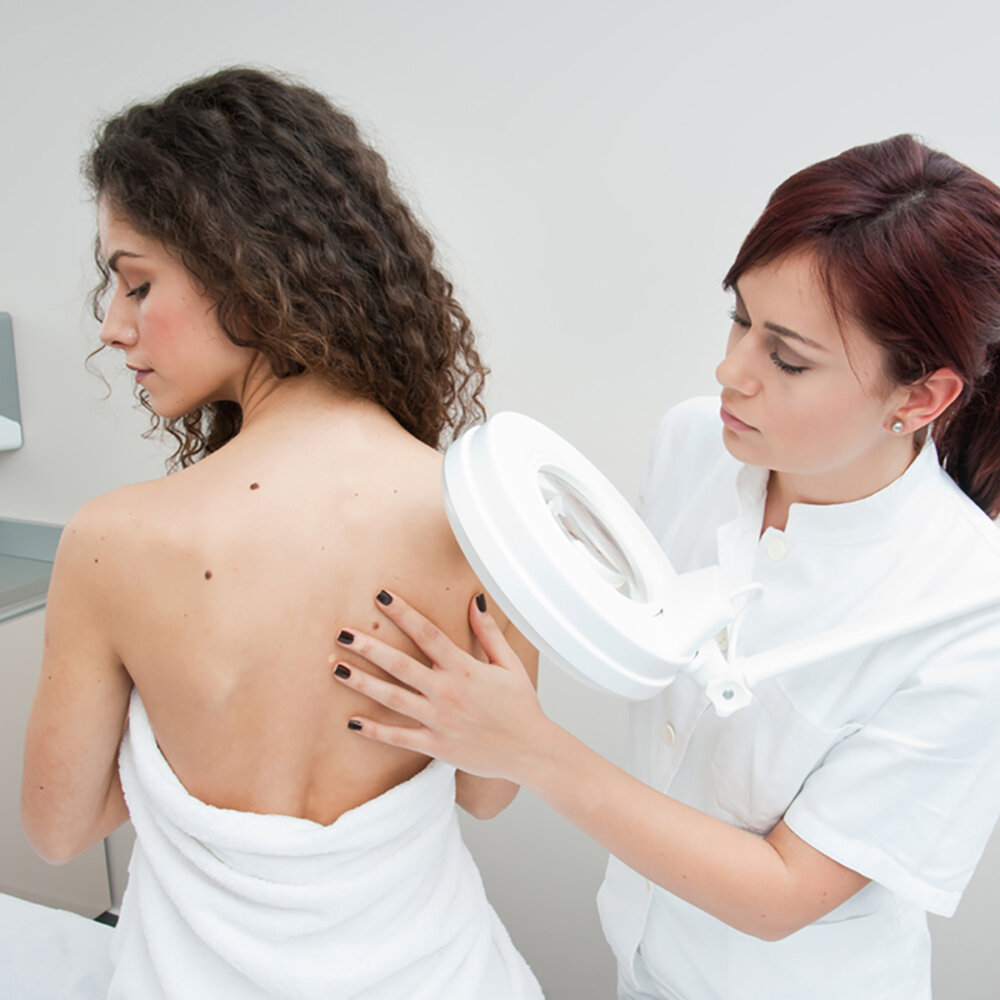
Diagnosis before mole removal treatment
Diagnosis before treatment of moles with the CO2 laser is an essential step to ensure that the mole to be removed does not present a risk of skin cancer, such as melanoma. Melanoma is a rare but very dangerous type of skin cancer that can spread to other organs and be fatal. It can develop from an existing mole or appear on an area of normal skin.
To make the diagnosis, you must consult an experienced dermatologist, who will examine the mole with the naked eye and with a device called a dermatoscope, which allows you to see the internal structures of the mole. The dermatologist will also inquire about the family history of melanoma, exposure to the sun, the number and evolution of moles. He will use the ABCDE rule to assess the risk of melanoma: Asymmetry, Irregular edges, Non-uniform color, Diameter greater than 6 mm, Rapid progression.
If the mole is suspicious, the dermatologist will remove it using a technique called excision, which involves cutting the mole with a scalpel under local anesthesia. The sample is then sent to a laboratory for a microscopic analysis, called a pathological examination, which can confirm or refute the diagnosis of melanoma.
If the mole is benign, the doctor may suggest removing it using the CO2 laser, which is a technique that allows the mole to be vaporized without leaving a scar. The CO2 laser is particularly suitable for raised moles, such as dermal nevi or Spitz moles. The treatment is carried out under local anesthesia, on an outpatient basis, that is to say without hospitalization. The laser beam is aimed at the mole and destroys it within seconds. A small crust forms on the treated area, and falls off after a few days. You must then protect the skin from the sun for a few months, as it can remain red and sensitive.
Diagnosis before treatment of moles with the CO2 laser is therefore an essential precautionary measure to avoid missing melanoma, which is a serious and potentially fatal disease. It is therefore important to consult a qualified specialist and regularly monitor the condition of your skin and moles.

How to remove a mole with a CO2 laser? Get rid of moles today!
What happens before this procedure?
Before a mole removal procedure, your doctor inspects your skin. They can take photos of your moles to compare them later. They may also use a tool called a dermoscope to take a closer look at the mole and determine the best way to remove it.
Your healthcare professional will mark the areas of your skin to be removed. Then they will clean the area. You will be given numbing medicine (anesthetic). This may be applied to your skin (topically) or you may receive an injection at the surgical site. Sometimes you'll get both.
Treatment of moles with the CO2 laser is a technique that allows skin growths to be removed quickly and painlessly. Here is the detailed treatment procedure for moles with the CO2 laser:
- Before treatment
Before treatment, you must consult a doctor to ensure that the mole to be treated does not present a risk of skin cancer, such as melanoma. The doctor can also inform you about the advantages and disadvantages of CO2 laser treatment, as well as the precautions to take after treatment.
- The day of treatment
On the day of treatment, the doctor may apply an anesthetic cream to the area to be treated, and wait about 30 minutes for the effect to be felt. He can also offer you local anesthesia by injection, depending on your sensitivity and the size of the mole.
The doctor then uses the CO2 laser to vaporize the mole. The CO2 laser is an ablative laser, meaning it destroys the pigment cells responsible for the color of the mole. The fractional CO2 laser is particularly suitable for treating raised moles, such as dermal nevi or Spitz moles. The treatment only lasts a few minutes and is not very painful.
- After treatment
After the treatment, the doctor applies a healing cream to the treated area, and gives you advice to promote healing. A small crust forms on the treated area, and falls off after a few days. You must then protect the skin from the sun for a few months, as it can remain red and sensitive. The main advantage of the CO2 laser is that it does not leave a scar, unlike traditional surgery.
Did you manage to get rid of moles with our specialists? So, some tips on post-treatment care.
- You should avoid touching, scratching or tearing off the scab that forms on the treated area, as it protects the skin and promotes healing. The crust must be allowed to fall naturally, which can take a few days to a few weeks depending on the method used.
- The treated area should be cleaned with mild soap and lukewarm water, then gently dried with a clean towel. You must then apply a healing or antiseptic cream, according to the doctor's recommendations, and cover the area with a dressing or steri-strips. The dressing or steri-strips should be changed every day or every two days, depending on the case.
- The treated area must be protected from the sun for several months, as the skin is more sensitive and more prone to pigment spots. You should use a high-factor sunscreen (SPF 50 or more) and wear covering clothing. You should also avoid heat sources, such as saunas, hammams or hair dryers.
- You should monitor the progress of the treated area and consult your doctor in the event of abnormal signs, such as persistent redness, swelling, pain, bleeding, infection, allergic reaction or change in the scar. You should also have your skin and moles checked regularly by a dermatologist to prevent the risk of skin cancer.
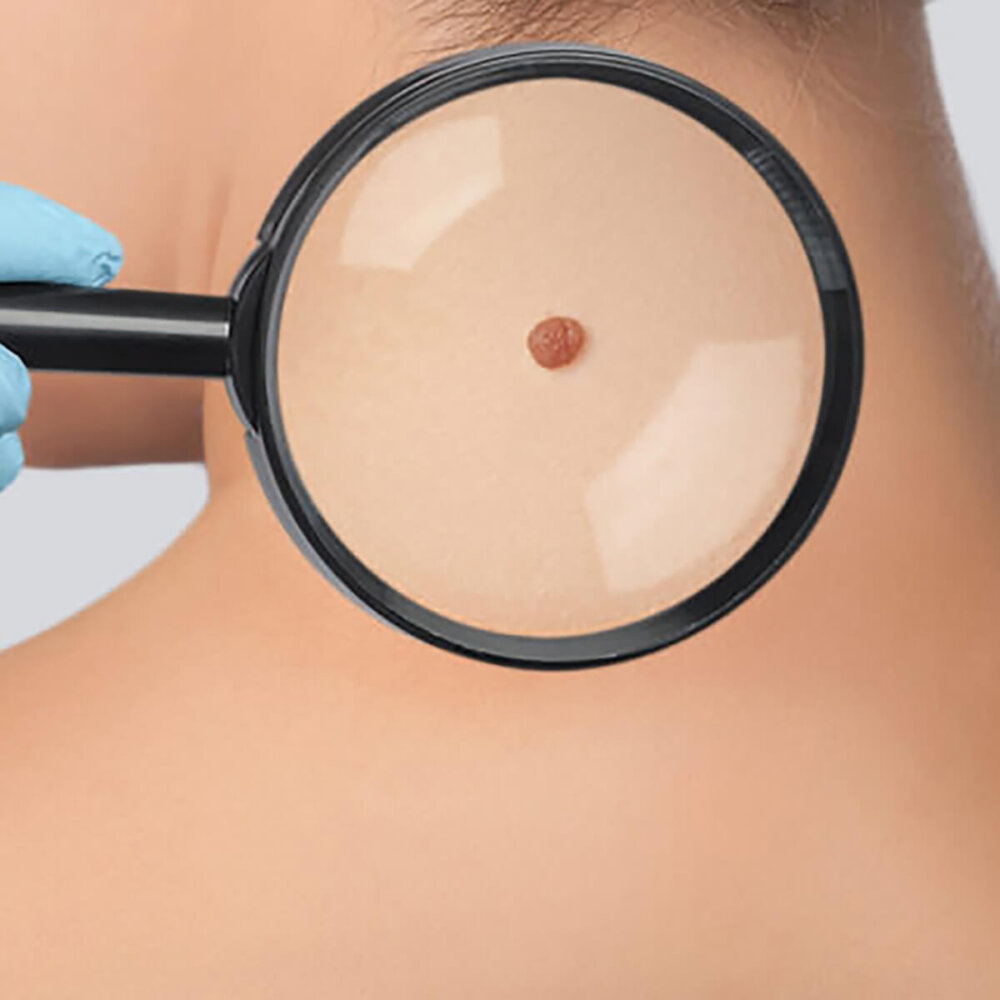
Contraindications or in which cases CO2 laser mole removal treatment is not recommended?
The CO2 laser has the advantage of being fast, painless and effective, but it is not suitable for all cases, and there are contraindications to respect before resorting to this treatment:
Suspicious or malignant moles that show signs of melanoma or other types of skin cancer. Melanoma is a rare but very serious skin cancer that can spread to other organs and be fatal. It can develop from an existing mole or appear on an area of normal skin. Before treating a mole with a CO2 laser, you must consult a dermatologist to make a precise diagnosis and a biopsy. If the mole is carcinogenic, it must be treated with larger surgery, which removes all the cancer cells and reduces the risk of recurrence.
Sensitivity to light, which can cause unwanted reactions during CO2 laser treatment. Some people have skin that is more sensitive to light than others, and may develop redness, burns, blisters or dark spots after exposure to the sun or laser beam. This sensitivity can be due to genetic factors, skin diseases, medications or cosmetics. Before treating a mole with a CO2 laser, you must inform the doctor of any known sensitivity to light, and avoid exposing yourself to the sun or heat sources in the days before and after the treatment.
Taking certain medications, which may interfere with CO2 laser treatment. Some medications can increase sensitivity to light, such as Roaccutane, a medication used to treat severe acne. Other medications can prevent blood clotting, such as anticoagulants, and increase the risk of bleeding during CO2 laser treatment. Before treating a mole with a CO2 laser, you must inform your doctor that you are taking these medications and follow his recommendations to adapt the treatment or temporarily suspend it.
Tanned skin, which can reduce the effectiveness of CO2 laser treatment and increase the risk of complications. Tanning is the result of the skin's defense reaction to the sun's ultraviolet rays. It results in an increase in the production of melanin, the pigment that colors the skin. The CO2 laser works by targeting the melanin of the mole, but if the skin is tanned, it can also reach the melanin of healthy skin, and cause burns, infections, scars or pigment spots. Before treating a mole with a CO2 laser, avoid exposure to the sun or artificial UV rays for at least one month before treatment, and use a high-factor sunscreen (SPF 50 or higher) on the area. treat.
Pregnancy, which should be avoided during CO2 laser treatment as a precaution. There is no scientific data proving that the CO2 laser is harmful to pregnant women or the fetus, but there is also no data proving that it is safe. Therefore, it is best to postpone CO2 laser treatment until after delivery unless medically necessary. Additionally, pregnancy can change skin pigmentation and make CO2 laser treatment less effective or more risky.
History of abnormal healing, which can lead to unsightly scarring after CO2 laser treatment. Some people have a tendency to develop hypertrophic or keloid scars, which are thick, red, blistered and painful scars that extend beyond the original wound. These scars can be due to genetics, repeated trauma, infections, or excessive tension on the skin. Before treating a mole with a CO2 laser, you must inform the doctor of any history of abnormal healing, and follow his advice to prevent or treat these scars.
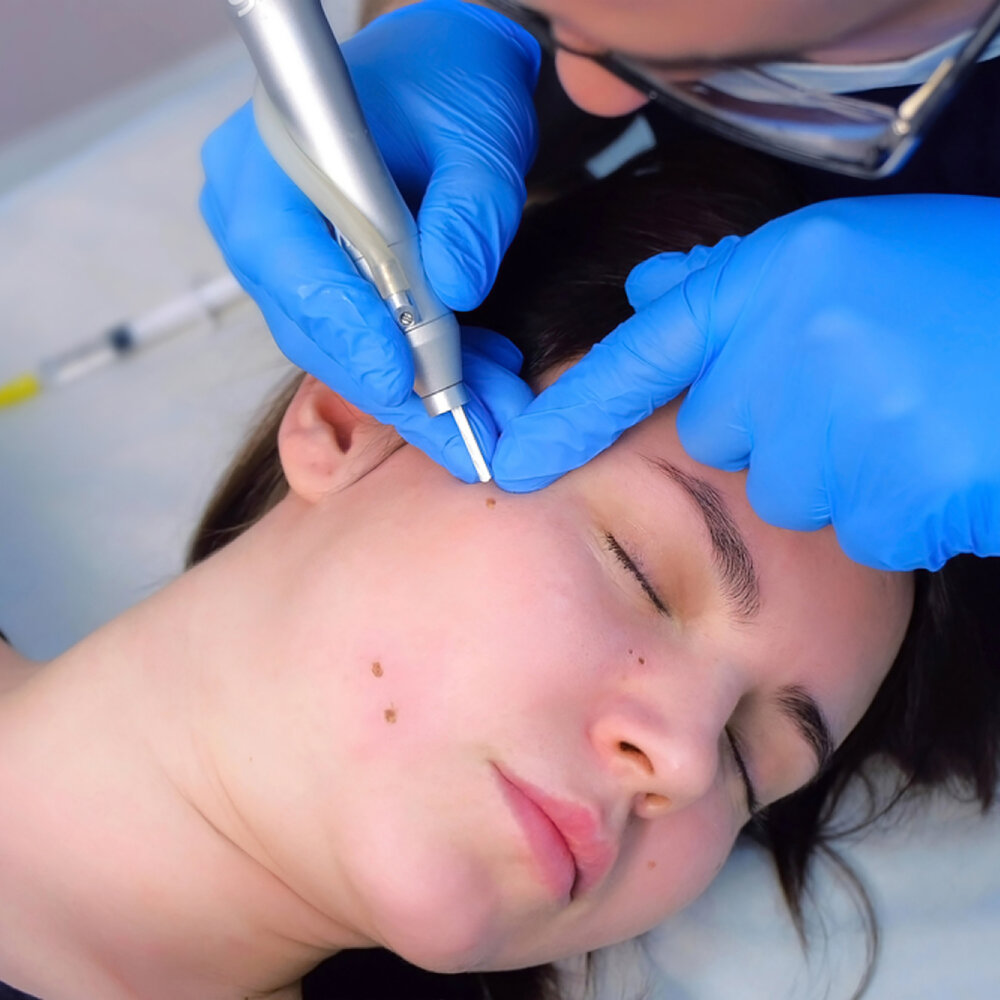
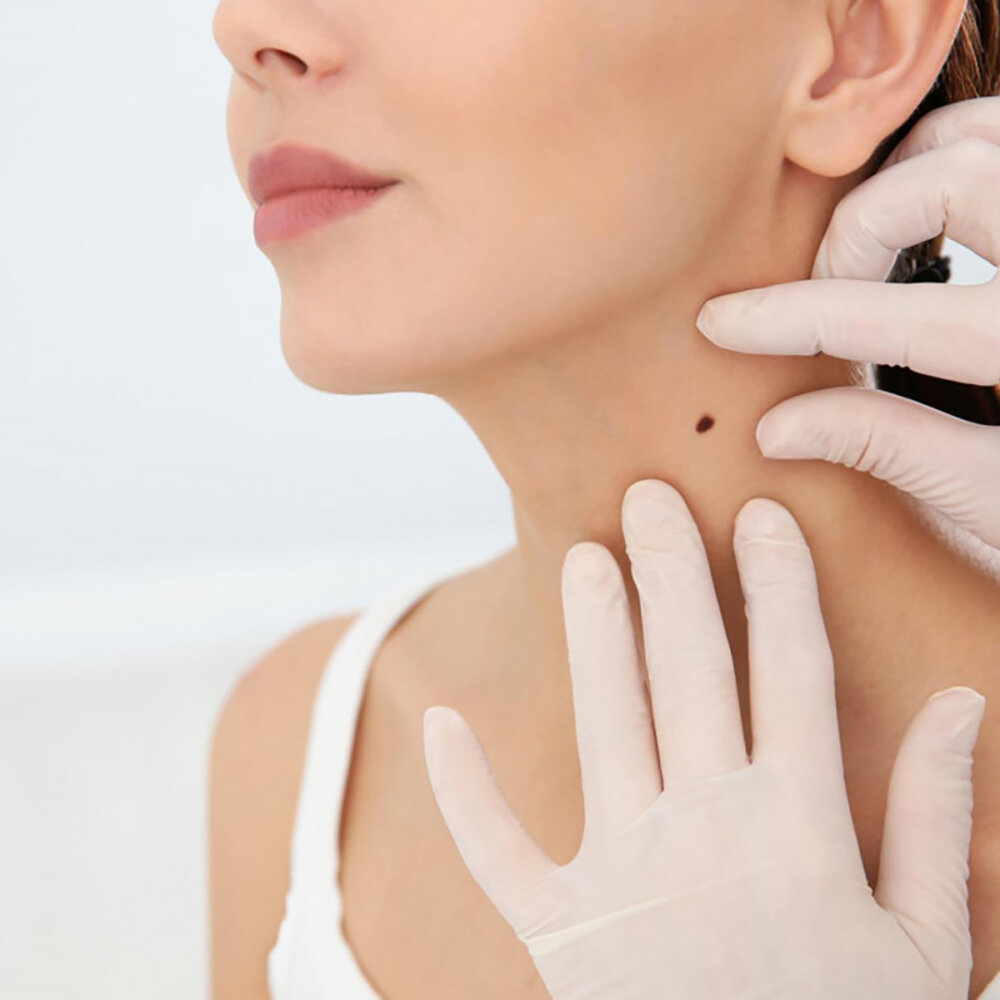
When should you call the doctor? The specialists of our clinic are always available for you
Most moles are harmless and do not need to be removed. But you should check your moles regularly and note any changes. Contact your healthcare professional if your mole:
- Is painful or itchy.
- Has discharge or bleeding.
- Grows or changes shape.
- Has irregular sides (not the same shape all around).
- Appear after 30 years.
After removing a mole with the CO2 laser, it is normal for the treated area to have a small crust and redness for a few days or weeks. These signs indicate that the skin is healing and that it should be protected from the sun and friction. There is no need to contact your doctor if you do not experience pain, infection or bleeding.
However, you should contact your doctor in the following cases:
- If the scab does not fall off after two weeks, or if it reforms after falling off.
- If the redness persists for more than three months, or if it worsens or spreads.
- If the treated area changes color, shape, size or feel.
- If you notice the appearance of new moles on or near the treated area.
- If you have doubts or questions about the aesthetic result or the risk of skin cancer.
These situations may indicate a complication, an allergic reaction, an infection, abnormal healing or a malignant development of the mole. It is therefore important to consult a specialist for a suitable diagnosis and treatment. The CO2 laser is an effective and safe technique for removing moles, but it requires regular medical follow-up and monitoring of your skin.
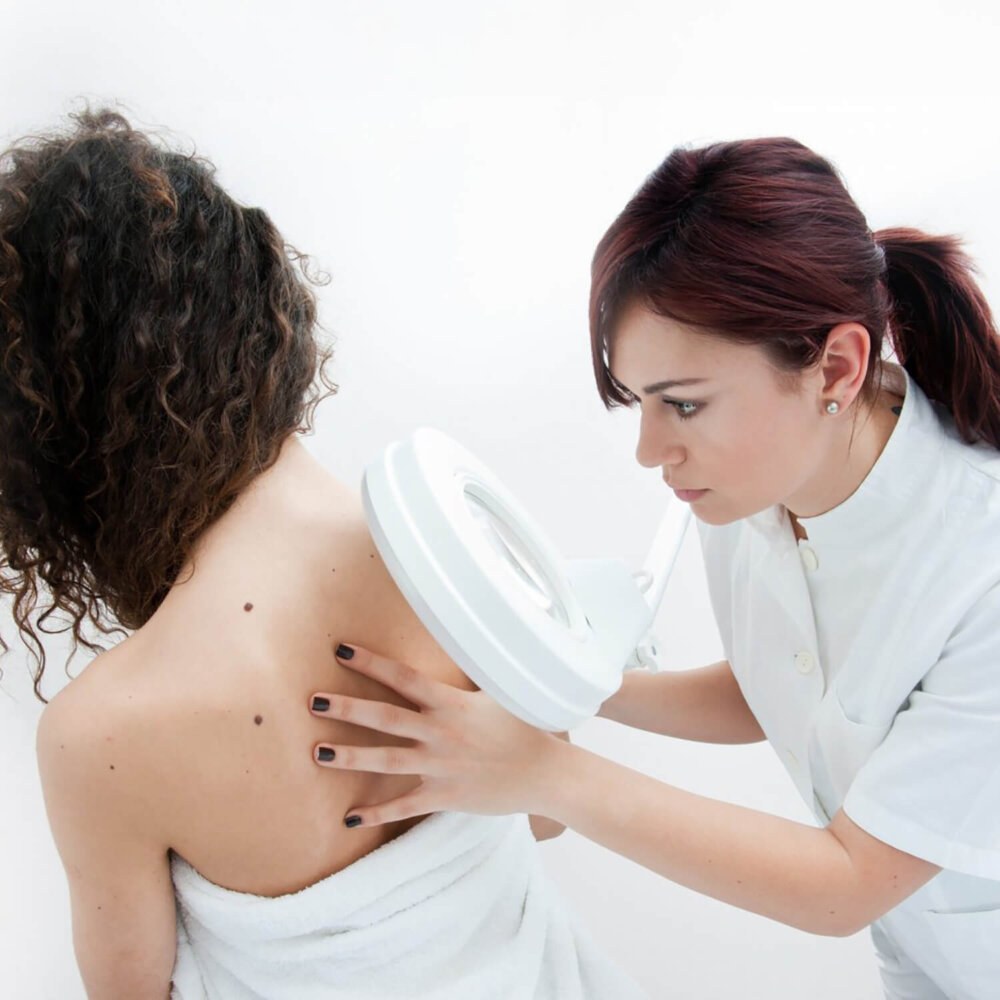
Can I remove a mole myself?
Or is it better to make an appointment with a professional?
No, you should not try to remove a mole yourself. This can be dangerous for your health and your skin. Here's why :
- You could damage your skin by using unapproved methods, such as vinegar, garlic, lemon juice or scissors. These methods can cause burns, infections, scarring or bleeding.
- You might miss a sign of skin cancer. Some moles may be melanomas, a very dangerous type of skin cancer. If you try to remove them yourself, you may not remove all the cancer cells, which can cause them to spread to other organs. Only a doctor can make an accurate diagnosis and appropriate treatment.
- You may have an unsatisfactory aesthetic result. By removing a mole yourself, you may leave a more visible mark than the mole itself. You could also cause an allergic reaction or inflammation of the skin. A doctor can suggest safer, more effective techniques, such as laser, shaving or excision, that leave little or no scarring.
The best way to remove a mole is to consult a doctor, who can advise you on the most appropriate treatment options for your case. He will also be able to inform you about the risks and benefits of each method, as well as the precautions to take after treatment. Don't take unnecessary risks with your skin and health, and trust a professional.
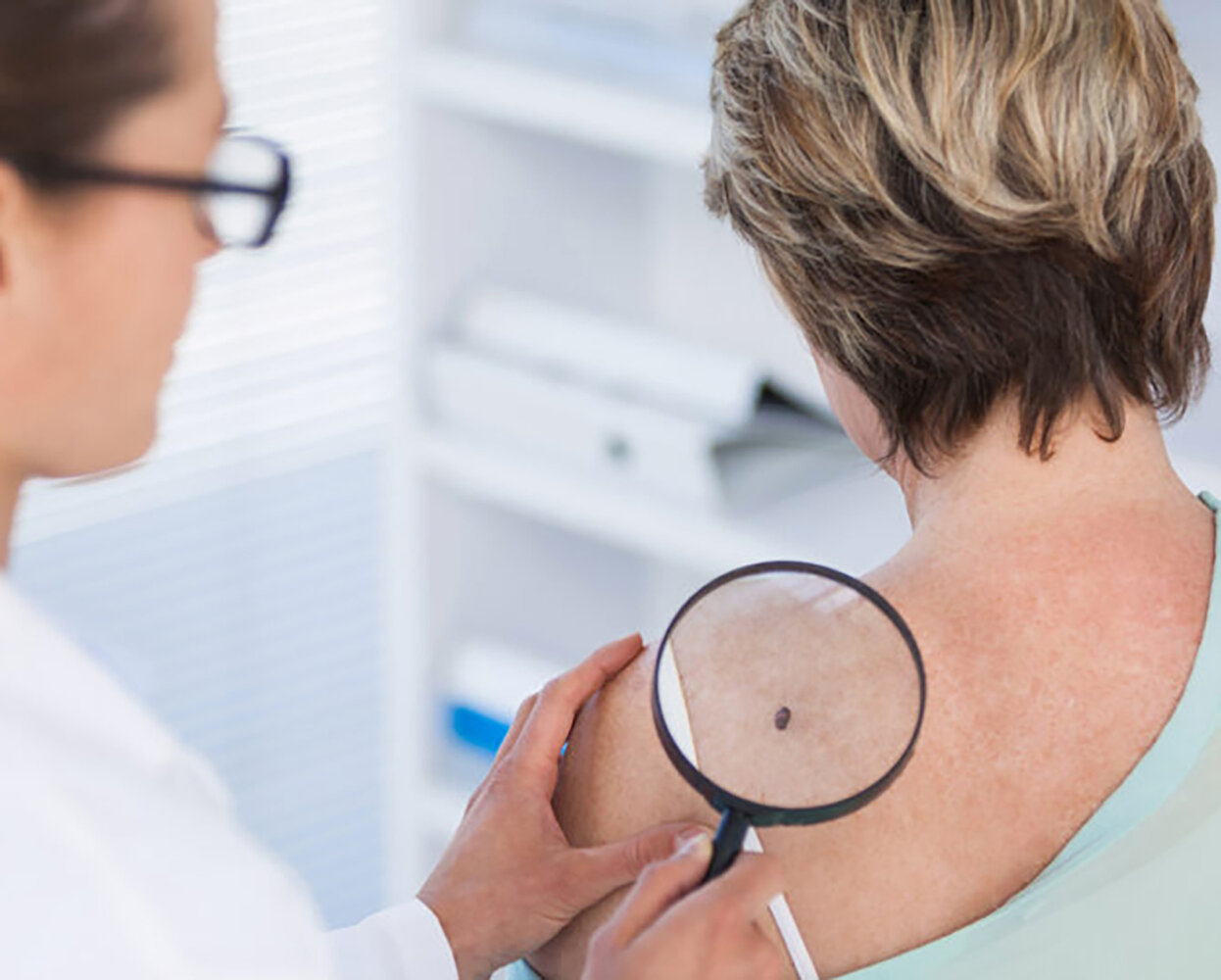
Can moles be removed permanently?
Moles can be permanently removed by different methods, such as excision, freezing or laser. However, you should consult a doctor before removing a mole, as some may be signs of skin cancer. You should also avoid trying to remove a mole yourself, as this can cause complications, infections or scarring. Here is some additional information about moles and their removal:
- Moles are skin formations, generally dark, derived from the cells that pigment the skin (melanocytes). Most people have moles, but the propensity to develop atypical moles is sometimes hereditary. Moles and atypical moles that change significantly should be biopsied to screen for melanoma, a skin cancer.
- Moles can be located anywhere on the body. They track changes in hormone levels in women and may darken during pregnancy. Once formed, moles never disappear, but may become lighter, more raised, or fleshier.
- Dermatologists or aesthetic surgeons can remove moles by excision (cutting), freezing with liquid nitrogen, or burning. These methods are generally quick, painless, and effective, but they may leave a small scar. The CO2 laser is a technique that allows the mole to be vaporized without leaving a scar, but it requires regular medical follow-up and monitoring of the skin.
- Before removing a mole, you must consult a dermatologist to ensure that it is not carcinogenic. If the mole shows signs of melanoma or other types of skin cancer, the dermatologist will take a biopsy to confirm or rule out the diagnosis. If the mole is benign, the dermatologist can suggest removing it using the method best suited to the patient's case.
- You should never try to remove a mole yourself, as this can be dangerous for your health and skin. Using unapproved methods, such as vinegar, garlic, lemon juice or scissors, can damage the skin, cause burns, infections, bleeding or scarring. You can also miss a sign of skin cancer, which can have serious consequences. You should always trust a qualified professional to remove a mole.


